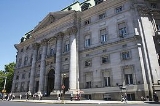
Economy of Argentina
Encyclopedia
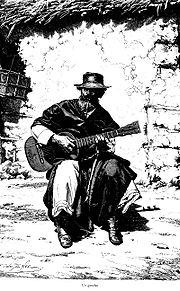
Emergence into the world economy
Prior to the 1880s, Argentina was a relatively isolated backwater, dependent on the woolWool
Wool is the textile fiber obtained from sheep and certain other animals, including cashmere from goats, mohair from goats, qiviut from muskoxen, vicuña, alpaca, camel from animals in the camel family, and angora from rabbits....
, leather
Leather
Leather is a durable and flexible material created via the tanning of putrescible animal rawhide and skin, primarily cattlehide. It can be produced through different manufacturing processes, ranging from cottage industry to heavy industry.-Forms:...
and hide industry for both the greater part of its foreign exchange and the generation of domestic income and profits. The Argentine economy began to experience swift growth after 1875 through the export of livestock and grain commodities, however, as well as through British and French investment, marking the beginning of a significant era of economic expansion.
During its most vigorous period, from 1880 to 1905, this expansion resulted in a 7.5-fold growth in GDP, averaging about 8% annually. One important measure of development, GDP per capita, rose from 35% of the United States average to about 80% during that period. Growth then slowed considerably, though throughout the period from 1890 to 1939, the country's per capita income was similar to that of France, Germany and Canada (although income in Argentina remained considerably less evenly distributed).
Development of land
Since becoming a nation in 1816, Argentina, being the eighth largest country in the world by area, has held an advantage in this factor of production. The rural economy was almost entirely devoted to subsistence farming in the early nineteenth century and above all, livestock raising, which spread quickly in Argentina's mild climate. Moreover, during periods of falling prices for their products ranchers were able to maintain positive returns, proving their resilience in a volatile market. Over the next few decades, cattle and sheep ranchers became the most influential men in Argentina, as their exports became the unstable young country's nearly sole source of foreign exchange.Labor-intensive crop farming languished for much of this era, the victim of internecine wars, an acute shortage of labor, a lack of qualified agronomists and livestock ranchers' opposition. Following a decade of revolution, however, focus changed toward the development of grain farming and after 1861, during Bartolomé Mitre
Bartolomé Mitre
Bartolomé Mitre Martínez was an Argentine statesman, military figure, and author. He was the President of Argentina from 1862 to 1868.-Life and times:...
's difficult presidency, the first institute of Agronomy
Agronomy
Agronomy is the science and technology of producing and using plants for food, fuel, feed, fiber, and reclamation. Agronomy encompasses work in the areas of plant genetics, plant physiology, meteorology, and soil science. Agronomy is the application of a combination of sciences like biology,...
and the first initiatives encouraging immigration were given life.
Livestock raising required relatively few gauchos and continued to dominate land use; but, in 1875, the first Argentine grain shipment to arrive intact in Europe ignited an agricultural boom that soon replaced vast tracts of lands once devoted to livestock with "waves of grain." The leading outlet of European investment in Argentina after 1875, railways
Rail transport in Argentina
The Argentine railway network comprised of track at the end of the Second World War and was, in its time, one of the most extensive and prosperous in South America. However, with the increase in highway construction, there followed a sharp decline in railway profitability, leading to the break-up...
, themselves helped harness the country's vast land resources, reducing a typical journey from the hinterland to port for both crops and passengers from a month to two days. British capital and European immigration quickly followed, easing capital, skills and labor shortfalls without which the development of modern Argentina would not have been possible.
Development of the labour market
Immigration was central to Argentina's development. Prior to the 1860s, there was relatively little migration into the country; the population in 1869 was less than 2 million and, due to the sparse population, vast tracts of land remained unutilized. Labour shortages became widespread, resulting in the growth of real wages and, consequently, an increasing gap between the wage rates of Argentina and Europe. This facilitated a nearly-uninterrupted mass immigration until World War I and by 1914, one third of ArgentinaArgentina
Argentina , officially the Argentine Republic , is the second largest country in South America by land area, after Brazil. It is constituted as a federation of 23 provinces and an autonomous city, Buenos Aires...
's 8 million people had been born elsewhere, mostly in Italy and Spain. Eighty percent of Argentina's population were, by then, European immigrants, their children, or grandchildren.
In all, over 4 million Europeans
Demographics of Europe
Figures for the population of Europe vary according to which definition of European boundaries is used. The population within the standard physical geographical boundaries was 731 million in 2005 according to the United Nations. In 2010 the population is 857 million, using a definition which...
migrated to Argentina permanently between 1857 and 1950, and another 3 million passed through as seasonal workers, often moving on to the United States. Because the immigrants that stayed were much less likely to be field laborers than those that moved on, immigration helped quickly urbanize Argentina and its urban population tripled to over 4 million between 1895 and 1914, alone. The establishment of a national system
Education in Argentina
Education in Argentina is a responsibility shared by the national government, the provinces and federal district and private institutions, though basic guidelines have historically been set by the Ministry of Education...
of free, universal grade schools by Education Minister (and later, President) Domingo Sarmiento during the 1860s and 1870s raised literacy rates from 22% in 1869 to 65% in 1914 and helped further consolidate a modern labor structure.
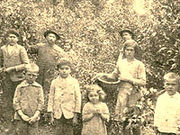
Argentina's commodity export market became less dependent on beef
Argentine beef
Beef is a key component of traditional Argentine cuisine.-Current situation:Argentina has the world's second highest consumption rate of beef, at 55 kg a year per capita. In 2006, livestock farmers kept between 50 and 55 million head of cattle, mostly in the fertile pastures of the Pampas...
and quickly diversified into wheat
Wheat
Wheat is a cereal grain, originally from the Levant region of the Near East, but now cultivated worldwide. In 2007 world production of wheat was 607 million tons, making it the third most-produced cereal after maize and rice...
and maize
Maize
Maize known in many English-speaking countries as corn or mielie/mealie, is a grain domesticated by indigenous peoples in Mesoamerica in prehistoric times. The leafy stalk produces ears which contain seeds called kernels. Though technically a grain, maize kernels are used in cooking as a vegetable...
. Accessible education and the relatively capital-intensive nature of Argentine agriculture
Agriculture in Argentina
Agriculture is one of the bases of Argentina's economy.Argentine agriculture is relatively capital intensive, today providing about 7% of all employment, and, even during its period of dominance around 1900, accounting for no more than a third of all labor. Having accounted for nearly 20% of GDP as...
itself (which, as early as 1895, employed only a third of all labor) helped likewise redirect most of this immigrant labor into the service and industrial sectors and for the most part, this helped fortify the country against market shocks (though certainly not internal, social or political disturbances). Many of the social upheavals during this period of emergence were caused by poor labor conditions and standards of living. Argentina's economy and labor movement developed almost in parallel. The first to organize were the printing
Printing
Printing is a process for reproducing text and image, typically with ink on paper using a printing press. It is often carried out as a large-scale industrial process, and is an essential part of publishing and transaction printing....
workers, in 1872, and the retail workers soon followed. These development later caught the attention of the administration of President Julio Roca, whose hostility against trade unions culminated in an 1888 massacre. These excesses helped lead to the formation of the Argentine Workers' Federation, the first national trade union center
National trade union center
A national trade union center is a federation or confederation of trade unions in a single country. Nearly every country in the world has a national trade union center, and many have more than one. When there is more than one national center, it is often because of ideological differences—in some...
in the country.
Resisted by successive administrations, the drive for reform gained momentum following the election to the Argentine Chamber of Deputies
Argentine Chamber of Deputies
The Chamber of Deputies is the lower house of the Argentine National Congress. This Chamber holds exclusive rights to create taxes, to draft troops, and to accuse the President, the ministers and the members of the Supreme Court before the Senate....
of its first Socialist Congressman, Alfredo Palacios
Alfredo Palacios
Alfredo Lorenzo Palacios was an Argentine socialist politician.Palacios was born in Buenos Aires, and studied law at Universidad de Buenos Aires, after graduation he became a lawyer and taught at the university until becoming a dean.In 1902, he was elected to the Buenos Aires' legislature, and in...
, in 1904. Commissioning a study on contemporary urban social conditions, Palacios demonstrated that poverty rates approached 90%, helping lead to the 1905 prohibition of women and children from risky occupations, the establishment of a minimum working age (13), and the introduction of a 60-hour, six-day workweek. These reforms did not improve the lot of most unskilled workers in the then-feudal north, least of all the several hundred thousand sugarcane
Sugarcane
Sugarcane refers to any of six to 37 species of tall perennial grasses of the genus Saccharum . Native to the warm temperate to tropical regions of South Asia, they have stout, jointed, fibrous stalks that are rich in sugar, and measure two to six metres tall...
, cotton
Cotton
Cotton is a soft, fluffy staple fiber that grows in a boll, or protective capsule, around the seeds of cotton plants of the genus Gossypium. The fiber is almost pure cellulose. The botanical purpose of cotton fiber is to aid in seed dispersal....
and tobacco
Tobacco
Tobacco is an agricultural product processed from the leaves of plants in the genus Nicotiana. It can be consumed, used as a pesticide and, in the form of nicotine tartrate, used in some medicines...
plantation workers, who began migrating in large numbers to urban areas in their own region and in the more prosperous central areas of the country. The distribution of income largely improved, however, and improving social conditions contributed to the overall, successful level of development the country experienced between 1870 and 1930.
Development of capital markets
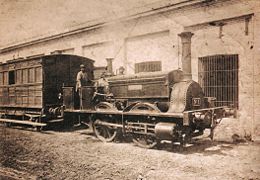
The United Kingdom contributed more direct investment into Argentina during this period than all other sources combined, as it did for many other Latin American states in that era. Large-scale British investment began around 1875 and by 1890, British nationals held a cumulative 180 million pounds Sterling
Pound sterling
The pound sterling , commonly called the pound, is the official currency of the United Kingdom, its Crown Dependencies and the British Overseas Territories of South Georgia and the South Sandwich Islands, British Antarctic Territory and Tristan da Cunha. It is subdivided into 100 pence...
(over US$800 million) in direct investments. Argentina had become, by then, the leading destination for British investment in the world. Though most of these funds found their way into productive activities such as rail transport, port development, mortgage bank
Mortgage bank
A Mortgage bank specializes in originating and/or servicing mortgage loans.A mortgage bank is a state-licensed banking entity that makes mortgage loans directly to consumers...
ing and public services
Public services
Public services is a term usually used to mean services provided by government to its citizens, either directly or by financing private provision of services. The term is associated with a social consensus that certain services should be available to all, regardless of income...
, fully a third was channelled into Argentine government bonds
Bond (finance)
In finance, a bond is a debt security, in which the authorized issuer owes the holders a debt and, depending on the terms of the bond, is obliged to pay interest to use and/or to repay the principal at a later date, termed maturity...
.
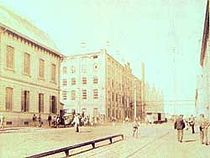
Gold standard
The gold standard is a monetary system in which the standard economic unit of account is a fixed mass of gold. There are distinct kinds of gold standard...
, for use mainly in foreign trade and financial markets, and paper peso
Argentine peso moneda nacional
The peso moneda nacional was the currency of Argentina between November 5, 1881 and December 31, 1969. It was subdivided into 100 centavos, with the argentino worth 5 pesos. Its symbol was m$n or $m/n. Its ISO 4217 code was ARM.-History:...
s worth roughly half the former's value, for use as monetary base
Monetary base
In economics, the monetary base is a term relating to the money supply , the amount of money in the economy...
. Lured by high rates of return, underwriters such as the influential Barings Bank
Barings Bank
Barings Bank was the oldest merchant bank in London until its collapse in 1995 after one of the bank's employees, Nick Leeson, lost £827 million due to speculative investing, primarily in futures contracts, at the bank's Singapore office.-History:-1762–1890:Barings Bank was founded in 1762 as the...
made Argentine and Uruguay
Uruguay
Uruguay ,officially the Oriental Republic of Uruguay,sometimes the Eastern Republic of Uruguay; ) is a country in the southeastern part of South America. It is home to some 3.5 million people, of whom 1.8 million live in the capital Montevideo and its metropolitan area...
an bonds the darlings of London speculators during the 1880s. These instruments began to lose value towards 1890, however, and before most investors could unload them, the pyramid scheme
Pyramid scheme
A pyramid scheme is a non-sustainable business model that involves promising participants payment or services, primarily for enrolling other people into the scheme, rather than supplying any real investment or sale of products or services to the public...
Barings built up collapsed
Panic of 1890
The Panic of 1890 was an acute depression, although less serious than other panics of the era. It was precipitated by the near insolvency of Barings Bank in London. Barings, led by Edward Baring, 1st Baron Revelstoke, faced bankruptcy in November 1890 due mainly to excessive risk-taking on poor...
. So serious were these losses (some involving the most prominent British families), only intervention by the Bank of England
Bank of England
The Bank of England is the central bank of the United Kingdom and the model on which most modern central banks have been based. Established in 1694, it is the second oldest central bank in the world...
averted a financial collapse.
.jpg)
Carlos Pellegrini
Carlos Enrique José Pellegrini Bevans was President of Argentina from 6 August 1890 to 12 October 1892....
's introduction of the first currency board
Currency board
A currency board is a monetary authority which is required to maintain a fixed exchange rate with a foreign currency. This policy objective requires the conventional objectives of a central bank to be subordinated to the exchange rate target....
in Argentina, which helped stabilize the currency, and maintain the Investment and thus the economy soon recovered; by 1914, Argentina's public external debt stood at US$784 million in (mostly) 41/2% bonds, with a further US$3.217 billion in foreign direct investment. Argentina stood out among Latin American states in terms of foreign direct investment
Foreign direct investment
Foreign direct investment or foreign investment refers to the net inflows of investment to acquire a lasting management interest in an enterprise operating in an economy other than that of the investor.. It is the sum of equity capital,other long-term capital, and short-term capital as shown in...
received during this era; nearly half of all British direct investment worldwide had, by then, been plowed into the Argentine economy.
The relatively sudden modernization in the Argentine economy in the generation until 1914 was achieved through investment from and exports to Europe. Dependent upon beef jerky and hides until the advent of refrigerated shipping in 1876, exports diversified into chilled beef and mutton, to cereals and eventually to some processed goods like flour, lard, canned luncheon meat and linseed oil
Linseed oil
Linseed oil, also known as flaxseed oil, is a clear to yellowish oil obtained from the dried ripe seeds of the flax plant . The oil is obtained by cold pressing, sometimes followed by solvent extraction...
. These were sent off to Europe, where rising living standards created a booming market for imported foodstuffs and other raw materials. In return, Great Britain
United Kingdom
The United Kingdom of Great Britain and Northern IrelandIn the United Kingdom and Dependencies, other languages have been officially recognised as legitimate autochthonous languages under the European Charter for Regional or Minority Languages...
, France and Germany invested in the development of Argentina, particularly in sectors that were oriented toward exports (such as Argentina's railways
Rail transport in Argentina
The Argentine railway network comprised of track at the end of the Second World War and was, in its time, one of the most extensive and prosperous in South America. However, with the increase in highway construction, there followed a sharp decline in railway profitability, leading to the break-up...
, still the most extensive in Latin America).
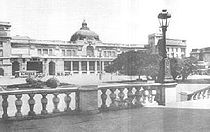
Rail transport in Argentina
The Argentine railway network comprised of track at the end of the Second World War and was, in its time, one of the most extensive and prosperous in South America. However, with the increase in highway construction, there followed a sharp decline in railway profitability, leading to the break-up...
and meat-packing industry
Argentine beef
Beef is a key component of traditional Argentine cuisine.-Current situation:Argentina has the world's second highest consumption rate of beef, at 55 kg a year per capita. In 2006, livestock farmers kept between 50 and 55 million head of cattle, mostly in the fertile pastures of the Pampas...
in particular, would have been severely limited without these investments. Domestic credit was scarce and start-up costs were often beyond the reach of local investors. Argentina's agricultural sector itself, however, developed into an export powerhouse that alone brought in nearly a billion dollars a year by the late 1920s with virtually no foreign investment and comparatively little domestic credit; in all, foreign investment accounted for one third of the nation's capital stock (buildings and equipment) by 1900, and nearly half by 1913.
Appraisal and the twilight of export-led growth

Cuba
The Republic of Cuba is an island nation in the Caribbean. The nation of Cuba consists of the main island of Cuba, the Isla de la Juventud, and several archipelagos. Havana is the largest city in Cuba and the country's capital. Santiago de Cuba is the second largest city...
). Growing domestic activity accounted for most of the era's economic growth itself, though the country's financial stability still remained deeply dependent on foreign investment and international economic sentiment.
Foreign investment and the commodity market can be extremely volatile. Because Argentina's economy relied so heavily on foreign credit and a demand for its agricultural products, it was particularly susceptible to these periods of volatility, which brought about severe repercussions for the country's economic growth. Foreign investment for Argentina, then, was a double-edged sword. While it contributed to the long period of growth between the late 19th and early 20th centuries, foreign investment dried up during World War I. Because national markets had not yet matured, the domestic economy was unprepared to make up for losses incurred by the international market shock and the economy, which had grown by an average of about 6% until 1913, shrank by 10% in 1914 and remained in low gear during the war.
The industrial era
The period between 1914 and 1945 challenged the Argentine economy, as it did most of the world's. Foreign investment disappeared during World War I to finance the European war effort, and failed to return after the peace. The Argentine economy retained close links to British trade and investment; but after 1918, a stronger commercial relationship emerged with the United States and Wall StreetWall Street
Wall Street refers to the financial district of New York City, named after and centered on the eight-block-long street running from Broadway to South Street on the East River in Lower Manhattan. Over time, the term has become a metonym for the financial markets of the United States as a whole, or...
, which now dominated the international economic stage.
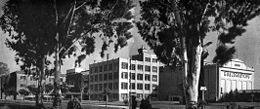
Sáenz Peña Law
The Sáenz Peña Law was Law 8871 of Argentina, sanctioned by the National Congress on 10 February 1912, which established the universal, secret and mandatory male suffrage though the creation of an electoral list...
and, in 1916, elected the country's first populist
Populism
Populism can be defined as an ideology, political philosophy, or type of discourse. Generally, a common theme compares "the people" against "the elite", and urges social and political system changes. It can also be defined as a rhetorical style employed by members of various political or social...
leadership. The new administration of longtime activist Hipólito Yrigoyen
Hipólito Yrigoyen
Juan Hipólito del Sagrado Corazón de Jesús Irigoyen Alem was twice President of Argentina . His activism became the prime impetus behind the obtainment of universal suffrage in Argentina in 1912...
extended subsidized loans to Argentina's then-sizable peasant
Peasant
A peasant is an agricultural worker who generally tend to be poor and homeless-Etymology:The word is derived from 15th century French païsant meaning one from the pays, or countryside, ultimately from the Latin pagus, or outlying administrative district.- Position in society :Peasants typically...
class and translated recently-found oil
Petroleum
Petroleum or crude oil is a naturally occurring, flammable liquid consisting of a complex mixture of hydrocarbons of various molecular weights and other liquid organic compounds, that are found in geologic formations beneath the Earth's surface. Petroleum is recovered mostly through oil drilling...
deposits into the country's first significant experiment with public enterprise
Government-owned corporation
A government-owned corporation, state-owned company, state-owned entity, state enterprise, publicly owned corporation, government business enterprise, or parastatal is a legal entity created by a government to undertake commercial activities on behalf of an owner government...
, the 1922 creation of the state oil concern YPF. Though it did not become a monopoly in the way Mexico's PEMEX
Pemex
Petróleos Mexicanos or Pemex is a Mexican state-owned petroleum company. As of 2010, with a total asset worth of $415.75 billion, it is the second non-publicly listed largest company in the world by total market value, and Latin America's second largest enterprise by annual revenue as of 2009...
did, YPF yielded about 15000 barrels (2,384,809.4 l) daily by 1930 (a fourth of Argentina's oil needs) and its success (albeit modest) made it a target of Standard Oil
Standard Oil
Standard Oil was a predominant American integrated oil producing, transporting, refining, and marketing company. Established in 1870 as a corporation in Ohio, it was the largest oil refiner in the world and operated as a major company trust and was one of the world's first and largest multinational...
.
Economic growth returned to around 6% annually during the 1920s, making it the richest country in the region on a per capita basis; by 1929, for instance, there were over 400,000 motor vehicles in the country (more than any other in Latin America). The 1929 stock market collapse
Wall Street Crash of 1929
The Wall Street Crash of 1929 , also known as the Great Crash, and the Stock Market Crash of 1929, was the most devastating stock market crash in the history of the United States, taking into consideration the full extent and duration of its fallout...
, however, marked the end of Argentine hopes for a return to the export-led growth model. Suffering the brunt of public discontent (including at least one assassination attempt), the aging Yrigoyen was deposed in a quiet 1930 coup d'état
Coup d'état
A coup d'état state, literally: strike/blow of state)—also known as a coup, putsch, and overthrow—is the sudden, extrajudicial deposition of a government, usually by a small group of the existing state establishment—typically the military—to replace the deposed government with another body; either...
that placed him under house arrest and his point man at YPF, Enrique Mosconi
Enrique Mosconi
Enrique Carlos Alberto Mosconi was an Argentine military engineer, who is best known as the pioneer and organizer of petroleum surveyance and exploitation in Argentina....
, into exile. Per capita GDP, meanwhile, plummeted almost as quickly as it did in the United States: in 1932 it reached its lowest level since 1902.
Import substitution industrialization

Laissez-faire
In economics, laissez-faire describes an environment in which transactions between private parties are free from state intervention, including restrictive regulations, taxes, tariffs and enforced monopolies....
approach with export-led growth, ISI meant direct government intervention. Though it had been larded with Standard Oil
Standard Oil
Standard Oil was a predominant American integrated oil producing, transporting, refining, and marketing company. Established in 1870 as a corporation in Ohio, it was the largest oil refiner in the world and operated as a major company trust and was one of the world's first and largest multinational...
and Royal Dutch Shell
Royal Dutch Shell
Royal Dutch Shell plc , commonly known as Shell, is a global oil and gas company headquartered in The Hague, Netherlands and with its registered office in London, United Kingdom. It is the fifth-largest company in the world according to a composite measure by Forbes magazine and one of the six...
lobbyists since after the 1930 coup, the Argentine government took a quick turn and by 1932, for example, it began levying gasoline taxes to fund its new highway bureau and began Argentina's first large-scale hydroelectric projects. The 1933 Roca-Runciman Agreement
Roca-Runciman Treaty
The Roca-Runciman Treaty was a commercial agreement between Argentina and Great Britain signed in London by the Vice President of Argentina, Julio Argentino Roca, Jr., and the president of the British Board of Trade, Sir Walter Runciman, the British envoy....
further regulated monetary and trade policy by tying both more closely to British markets, encouraging Argentine exports to markets in the U.K. and its colonies on condition that these surpluses be deposited in the Bank of England
Bank of England
The Bank of England is the central bank of the United Kingdom and the model on which most modern central banks have been based. Established in 1694, it is the second oldest central bank in the world...
.
Having recovered its lost ground by the late 1930s partly through import substitution, the economy continued to grow modestly during World War II (in sharp contrast to what had happened in the previous World War). Indeed, the reduced availability of imports and the war's beneficial effects on both the quantity and price of Argentine exports combined to create a US$ 1.7 billion cumulative surplus during those years. Benefiting from innovative self-financing and government loans alike, value added in manufacturing surpassed that of agriculture for the first time in 1943, and employed over 1 million by 1947.
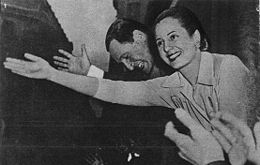
Politics of Argentina
The politics of Argentina take place in the framework of what the Constitution defines as a federal presidential representative democratic Republic, where the President of Argentina is both Head of State and Head of Government. Legislative power is vested in both the President and the two chambers...
that continue to exist in Argentina. Even before he took office in 1946, President Juan Perón
Juan Perón
Juan Domingo Perón was an Argentine military officer, and politician. Perón was three times elected as President of Argentina though he only managed to serve one full term, after serving in several government positions, including the Secretary of Labor and the Vice Presidency...
took dramatic steps that he felt would result in a more economically independent Argentina, better insulated from events such as World War II; Perón believed there would be a third. In his first two years in office alone, he nationalized the Central Bank, paid off its billion-dollar debt to the Bank of England
Bank of England
The Bank of England is the central bank of the United Kingdom and the model on which most modern central banks have been based. Established in 1694, it is the second oldest central bank in the world...
while repatriating frozen trade funds therein, nationalized
Railway Nationalisation in Argentina
In 1948, during President Juan Perón’s first term of office, the seven British-owned and three French-owned railway companies then operating in Argentina, were purchased by the state...
the railways (mostly owned by British and French companies), merchant marine
Ship transport
Ship transport is watercraft carrying people or goods . Sea transport has been the largest carrier of freight throughout recorded history. Although the importance of sea travel for passengers has decreased due to aviation, it is effective for short trips and pleasure cruises...
, universities, public utilities, public transport (then, mostly tramways) and, probably most significantly, created a single purchaser for the nation's mostly export-oriented grains and oilseeds: the IAPI.
Soon the central government's chief source of non-tax revenue
Non-tax revenue
Non-tax revenue or non-tax receipts are government revenue not generated from taxes. Examples include:* Aid from another level of government - for example, in the United States, federal grants may be considered non-tax revenue to the receiving states, and equalization payments* Aid from abroad *...
, the IAPI benefited from the jump in international grain demand and high prices during 1946-47. It helped finance generous social reforms and record public works investments (in particular, the construction of over 4000 hospitals and clinics and of over 8000 schools). Dormant mortgage and development loan programs were revitalized and the economy grew by over a fourth in 1946-48. These programs, among other things, eradicated tropical diseases in the underdeveloped north
Gran Chaco
The Gran Chaco is a sparsely populated, hot and semi-arid lowland region of the Río de la Plata basin, divided among eastern Bolivia, Paraguay, northern Argentina and a portion of the Brazilian states of Mato Grosso and Mato Grosso do Sul, where it is connected with the Pantanal region...
and the country's recurrent problem with locust
Locust
Locusts are the swarming phase of short-horned grasshoppers of the family Acrididae. These are species that can breed rapidly under suitable conditions and subsequently become gregarious and migratory...
s; but the IAPI soon began shortchanging growers and, when world grain prices dropped in the late 1940s, it stifled agricultural production, exports and business sentiment, in general. Argentine exports were, moreover, largely shut out of booming European markets by political pressure from the administration of U.S. President Harry S. Truman
Harry S. Truman
Harry S. Truman was the 33rd President of the United States . As President Franklin D. Roosevelt's third vice president and the 34th Vice President of the United States , he succeeded to the presidency on April 12, 1945, when President Roosevelt died less than three months after beginning his...
(which regarded Perón as an unapologetic fascist) and the resulting trade deficits of 1949-52 brought Argentina its first serious bout of stagflation
Stagflation
In economics, stagflation is a situation in which the inflation rate is high and the economic growth rate slows down and unemployment remains steadily high...
since World War I.
This crisis as well as the passing of the most influential and populist adviser in Perón's inner circle (his wife, Eva Perón
Eva Perón
María Eva Duarte de Perón was the second wife of President Juan Perón and served as the First Lady of Argentina from 1946 until her death in 1952. She is often referred to as simply Eva Perón, or by the affectionate Spanish language diminutive Evita.She was born in the village of Los Toldos in...
) led the President to adopt more business-friendly policies after 1952. His new policies reinvigorated exports and stimulated badly needed foreign investments in petroleum
Petroleum
Petroleum or crude oil is a naturally occurring, flammable liquid consisting of a complex mixture of hydrocarbons of various molecular weights and other liquid organic compounds, that are found in geologic formations beneath the Earth's surface. Petroleum is recovered mostly through oil drilling...
and the auto industry, while keeping wages high, labor rights strong and investment in public works in high gear; even after a conflict with the Roman Catholic Church
Roman Catholic Church
The Catholic Church, also known as the Roman Catholic Church, is the world's largest Christian church, with over a billion members. Led by the Pope, it defines its mission as spreading the gospel of Jesus Christ, administering the sacraments and exercising charity...
resulted in his overthrow (1955), this combination of policies remained (more or less) the general blueprint for economic policy for the next twenty years.
Developmentalism
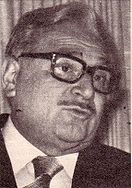
Mercantilism
Mercantilism is the economic doctrine in which government control of foreign trade is of paramount importance for ensuring the prosperity and security of the state. In particular, it demands a positive balance of trade. Mercantilism dominated Western European economic policy and discourse from...
model, the new regime's Civilian Advisory Board advised against drastic policy changes. This still left the question of the country's chronic trade deficits, which, though a modest US$200 million a year (2% of GDP), proved difficult to finance and was, thus, leading to periodic bouts of inflation. Elections in 1958 brought the moderate Arturo Frondizi
Arturo Frondizi
Arturo Frondizi Ercoli was the President of Argentina between May 1, 1958, and March 29, 1962, for the Intransigent Radical Civic Union.-Early life:Frondizi was born in Paso de los Libres, Corrientes Province...
to office and with him, two approaches to the problem. The first was a policy shared by Pres. Frondizi and his personal friend, businessman Rogelio Frigerio
Rogelio Frigerio
Rogelio Frigerio was an Argentine economist, journalist and politician.-Background and early career:Rogelio Frigerio was born in Buenos Aires in 1914 to Gerónimo Frigerio and Carmen Guanzaroli...
: developmentalism
Developmentalism
Developmentalism is an economic theory which states that the best way for Third World countries to develop is through fostering a strong and varied internal market and to impose high tariffs on imported goods....
. Encouraging investment in energy, industry and public works, as well a subsidies for domestic mortgage and business lending, it drew from previous efforts (such as Perón's post-1952 approach), though it was more ambitious in its bid for foreign investment and rather resembled Pres. Juscelino Kubitschek's policies in Brazil. The second entailed an austerity package of wage freezes, curbs on subsidies, credit controls and a sharp devaluation of the peso and was not supported by the president or Frigerio; but was imposed on Frondizi by the military through economist Alvaro Alsogaray
Álvaro Alsogaray
Álvaro Carlos Alsogaray was an Argentine politician and businessman. Minister of Economy during much of the 1959-62 period, he was one of the principal proponents of economic conservatism in modern Argentina.-Early career:...
, a defense contractor close to the landowning elite.
Bereft of a choice, Frondizi enacted these policies simultaneously and the results largely reflected it: Alsogaray's austerity measures (including a sharp devaluation
Devaluation
Devaluation is a reduction in the value of a currency with respect to those goods, services or other monetary units with which that currency can be exchanged....
) led to a sudden doubling of prices (a record at the time) and a consequent recession in 1959, the sharpest since 1930; but a wave of domestic and foreign investment from 1958 to 1962 resulted in three times more oil, steel and cement production, twice as much oil refining capacity and electric output and a several-fold increase in the production of consumer durables (in particular, auto production, which rose fourfold to 136,000 units, covering the domestic market). The combined slowing of domestic demand and sudden industrialization was consistent in one regard: the era of chronic trade deficits, for the time, ended in 1963. Their overcoming this obstacle allowed the new Administration of Dr. Arturo Illia to pursue vigorously pro-growth policies that included record public mortgage and business lending and generous wage guidelines, while balancing the national budget. The working and middle-classes benefited equally: poverty and unemployment fell sharply, while appliance, auto and home sales leapt to record levels. Pres. Illia, however, canceled important oil exploration contracts with foreign oil giants and, as Frondizi had done, allowed Peronist candidates for local and governors' posts to take office concessions the military had forbidden. Prosperity notwithstanding, these moves threw conservatives and most of the media against Illia, who was deposed in a quiet 1966 coup.

Argentine Industrial Union
The Argentine Industrial Union is the leading industrial advocacy group in Argentina, and one of the most influential in the country, in any sector.-Early development:...
(UIA), resulted in a general return to developmentalism
Developmentalism
Developmentalism is an economic theory which states that the best way for Third World countries to develop is through fostering a strong and varied internal market and to impose high tariffs on imported goods....
around 1968. Record public works and business investment reignited economic growth and by 1970, for instance, GDP had grown by 50% from 1963 levels, industrial production by 60% and auto sales had doubled. The boom's resulting rise in imports renewed calls for austerity among inflation hawks which, in 1970, placed the new de facto President, Gen. Roberto M. Levingston
Roberto M. Levingston
Roberto Marcelo Levingston Laborda was a general in theArgentine Army and president of Argentina from June 18, 1970 to March 22, 1971, during the Revolución Argentina period in Argentine history...
, in a position similar to Frondizi's a decade earlier. Like Frondizi, he appointed a conservative Economy Minister; but relied on a pro-industry policy maker, Production Minister Aldo Ferrer
Aldo Ferrer
Aldo Ferrer is a prominent Argentine economist and policy maker.-Early career:Aldo Ferrer was born in Buenos Aires in 1927, and enrolled at the University of Buenos Aires School of Economics, where he received a Doctorate in 1949...
. The pragmatic Pres. Levingston, in September 1970, had Ferrer, Frondizi and other moderates draft a "five-year plan" creating a national small-business lender and other new incentives for local investment in energy and industry, as well as regulations on foreign investment designed to encourage reliance on Argentine products and skill. The plan, however, also catered to Levingston's personal political ambitions and resulted in his being replaced the next March. Ferrer's proposals, even so, were left largely intact and were complemented by Social Policy Minister Francisco Manrique
Francisco Manrique
Francisco Manrique was an Argentine naval officer, journalist, policy maker and presidential candidate.-Life and times:...
's public housing and public health programs the most comprehensive Argentina had ever seen.
These accomplishments, however, suffered from a background of repression
La Noche de los Bastones Largos
La Noche de los Bastones Largos was the violent dislodge of five faculties of the University of Buenos Aires in Argentina on July 29, 1966 by the Federal Police...
that had resulted in increasing labor and student unrest, particularly since 1969. Skillfully co-opting these movements from exile, Juan Perón pressured the military regime into calling free elections in March 1973, which, won by his Justicialist Party
Justicialist Party
The Justicialist Party , or PJ, is a Peronist political party in Argentina, and the largest component of the Peronist movement.The party was led by Néstor Kirchner, President of Argentina from 2003 to 2007, until his death on October 27, 2010. The current Argentine president, Cristina Fernández de...
in a landslide, resulted in the aging leader's return from exile that June.
Appraisal
InflationInflation
In economics, inflation is a rise in the general level of prices of goods and services in an economy over a period of time.When the general price level rises, each unit of currency buys fewer goods and services. Consequently, inflation also reflects an erosion in the purchasing power of money – a...
first became a chronic problem during this period (it averaged 26% annually from 1944 to 1974) and Argentina did not become "industrialized" or fully "developed"; but, from 1932 to 1974, Argentina's economy grew almost fivefold (or 3.8% in annual terms) while its population only doubled. Though unremarkable, this expansion was well-distributed and so resulted in very positive changes in Argentine society
Culture of Argentina
The culture of Argentina is as varied as the country's geography and mix of ethnic groups. Modern Argentine culture has been largely influenced by European immigration although there are lesser elements of Amerindian and African influences, particularly in the fields of music and art...
, most notably the development of the largest proportional middle class (40% of the population by the 1960s) in Latin America as well as the region's best-paid, most unionized working class.
Crisis and coup
Perón's Economy Minister, José Ber GelbardJosé Ber Gelbard
José Ber Gelbard was an Argentine activist and politician.-Career:Gelbard was born in Radomsko, Poland, in 1917. In 1930 Gelbard emigrated to Argentina with his parents and siblings. They settled in Tucumán, north of Buenos Aires. Those were tough times and Gelbard had to make a living as a...
, attempted to preserve a balance between management and labor needs with a "social pact" entitling labor to generous, though measured, wage hikes, as well as price controls on consumer goods. This resulted in record real median wages about 50% higher than those in 1963 (or in 2008) and a re-acceleration in growth (6% yearly in 1973-74 and 80% above 1963 levels).
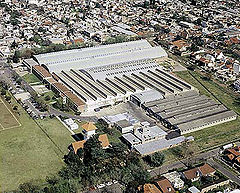
1973 oil crisis
The 1973 oil crisis started in October 1973, when the members of Organization of Arab Petroleum Exporting Countries or the OAPEC proclaimed an oil embargo. This was "in response to the U.S. decision to re-supply the Israeli military" during the Yom Kippur war. It lasted until March 1974. With the...
, however, the pact began to unravel (particularly following Perón's July 1974 death). Although Argentina was nearly self-sufficient in petroleum, the oil price shock adversely impacted the nation's delicate financial balance; it, in part, caused the nation's foreign oil bill to jump from US$60 million to US$600 million in 1974 and indirectly helped erase the rest of the nation's record billion-dollar 1973 trade surplus. This adverse turn might have been better managed had it not been that the Peronists were under pressure from their political base (the unions, in particular) to avoid a recession at almost any cost (a consideration painfully denied them by Economy Minister Alvaro Alsogaray
Álvaro Alsogaray
Álvaro Carlos Alsogaray was an Argentine politician and businessman. Minister of Economy during much of the 1959-62 period, he was one of the principal proponents of economic conservatism in modern Argentina.-Early career:...
in 1959 and in 1962). Refusing to resort to borrowing and unable, by 1975, to control soaring budget and trade deficits, as well as a wave of violence between Trotskyite and fascist extremists, the Peronist government resorted to a chaos of sharp currency devaluations and erratically timed wage hikes and freezes. In a seemingly never-ending tide of near-hyperinflation, strikes, business lockout
Lockout (industry)
A lockout is a work stoppage in which an employer prevents employees from working. This is different from a strike, in which employees refuse to work.- Causes :...
s and violence, the military took power in a March 1976 coup.
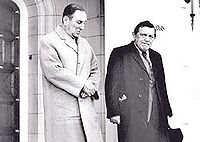
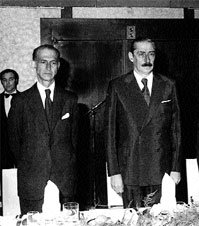
Minister of Economy of Argentina
The Minister of Economy is the head of the Ministry of Economy and Production of Argentina, concerned with finance and monetary matters. The position within the Government of Argentina is analogous to the finance ministers of some countries and the United States Treasury Secretary...
in particular with ultra-conservative
Conservatism
Conservatism is a political and social philosophy that promotes the maintenance of traditional institutions and supports, at the most, minimal and gradual change in society. Some conservatives seek to preserve things as they are, emphasizing stability and continuity, while others oppose modernism...
ideologues, many of them scions of Argentina
Argentina
Argentina , officially the Argentine Republic , is the second largest country in South America by land area, after Brazil. It is constituted as a federation of 23 provinces and an autonomous city, Buenos Aires...
's old agricultural elites. In touch with the investors' and exporters' legitimate need for stability but quick to order wage freezes that often lasted months, these Cambridge
University of Cambridge
The University of Cambridge is a public research university located in Cambridge, United Kingdom. It is the second-oldest university in both the United Kingdom and the English-speaking world , and the seventh-oldest globally...
and Chicago
University of Chicago
The University of Chicago is a private research university in Chicago, Illinois, USA. It was founded by the American Baptist Education Society with a donation from oil magnate and philanthropist John D. Rockefeller and incorporated in 1890...
-trained economists proved unable to curb the junta
National Reorganization Process
The National Reorganization Process was the name used by its leaders for the military government that ruled Argentina from 1976 to 1983. In Argentina it is often known simply as la última junta militar or la última dictadura , because several of them existed throughout its history.The Argentine...
's appetite for defense spending and unwilling to discourage speculators from taking advantage of Argentina's financial instability, often themselves profiting through the use of their advantage as insiders
Insider trading
Insider trading is the trading of a corporation's stock or other securities by individuals with potential access to non-public information about the company...
.
The dictatorship's chief economist, José Alfredo Martínez de Hoz
José Alfredo Martínez de Hoz
José Alfredo Martínez de Hoz was an Argentine executive and policy maker. He served as Minister of the Economy under de facto President Jorge Rafael Videla between 1976 and 1981, and shaped economic policy during the self-styled National Reorganization Process military dictatorship.-Early...
, advanced a monetarist financial liberalization that increased the debt burden. Critics charged these policies interrupted industrial development and upward social mobility. Buffeted by wage freezes difficult to oppose against the backdrop of massive human rights abuses
Dirty War
The Dirty War was a period of state-sponsored violence in Argentina from 1976 until 1983. Victims of the violence included several thousand left-wing activists, including trade unionists, students, journalists, Marxists, Peronist guerrillas and alleged sympathizers, either proved or suspected...
, real incomes fell by over a third that first year alone and have yet to fully recover. Unusually corrupt among the country's litany of often opprobrious past Economy Ministers, Martínez de Hoz also pursued free trade
Free trade
Under a free trade policy, prices emerge from supply and demand, and are the sole determinant of resource allocation. 'Free' trade differs from other forms of trade policy where the allocation of goods and services among trading countries are determined by price strategies that may differ from...
and a strong peso policy even as inflation
Inflation
In economics, inflation is a rise in the general level of prices of goods and services in an economy over a period of time.When the general price level rises, each unit of currency buys fewer goods and services. Consequently, inflation also reflects an erosion in the purchasing power of money – a...
ran at over 100% a year, encouraging a wave of imports that helped result in a 20% fall in industrial output Credit markets in New York and Paris meanwhile opened up to Argentina's profligate government and corrupt financiers alike, and by 1981 over US$30 billion in bad debts had piled up, destroying business confidence and forcing a ruinous run on banks and the peso
Argentine peso ley
The peso ley 18.188, usually known as either peso or, to distinguish it from the earlier peso moneda nacional, informally as peso ley, was the currency of Argentina between January 1, 1970 and May 5, 1983. It was subdivided into 100 centavos. Its symbol was $, sometimes $L. Its name comes from law...
.
Debt and depression
The combination of depressed real wages and financial chaos amounted to a "perfect storm" for the Argentine economy, made all the more difficult by the 1982 invasion of the Falkland IslandsFalkland Islands
The Falkland Islands are an archipelago in the South Atlantic Ocean, located about from the coast of mainland South America. The archipelago consists of East Falkland, West Falkland and 776 lesser islands. The capital, Stanley, is on East Falkland...
. GDP shrank by 12% in 1981-82, the sharpest decline since 1930, and over 400,000 companies of all sizes went bankrupt by 1982 One of the worst contributors to this crisis was probably the Central Bank "Circular 1050." The policy tied adjustable loan
Negative amortization
In finance, negative amortization, also known as NegAm, deferred interest or graduated payment mortgage, occurs whenever the loan payment for any period is less than the interest charged over that period so that the outstanding balance of the loan increases...
rates to the value of the U.S. dollar and consequently caused monthly interest payments to rise over ten-fold between early 1981 and mid-1982; by the end of this period, banks were writing off about 5% of their loan portfolios monthly. Fixed investment, which had weathered instability in the 1970s well, collapsed by almost 40% and stayed in low gear during the rest of the 1980s.
When the Falklands War
Falklands War
The Falklands War , also called the Falklands Conflict or Falklands Crisis, was fought in 1982 between Argentina and the United Kingdom over the disputed Falkland Islands and South Georgia and the South Sandwich Islands...
disaster brought new, more moderate leadership to the junta in July 1982, the new President of the Central Bank, Domingo Cavallo
Domingo Cavallo
Domingo Felipe "Mingo" Cavallo is an Argentine economist and politician. He has a long history of public service and is known for implementing the Convertibilidad plan, which fixed the dollar-peso exchange rate at 1:1 between 1991 and 2001, which brought the Argentine inflation rate down from over...
, quickly discarded the hated Circular 1050. More controversial was his initiative to aid manufacturers in debt (facing unaffordable US dollar payments), whereby he extended them a little-known loan guarantee designed to buffer their US Dollar-denominated debts from sharp falls in the Peso. Insiders, including Martínez de Hoz, had been enjoying this exchange rate guarantee since the Peso crisis began and Cavallo introduced limits to the program, such as the indexation
Indexation
Indexation is a technique to adjust income payments by means of a price index, in order to maintain the purchasing power of the public after inflation....
of installments. He was, however, sacked the next month and though it's often overlooked in debate, his successors over the next five years unethically extended the costly facility to all manner of debtors, adding up to US$15 billion to the national debt.
Facing a public howling for their heads, the junta
National Reorganization Process
The National Reorganization Process was the name used by its leaders for the military government that ruled Argentina from 1976 to 1983. In Argentina it is often known simply as la última junta militar or la última dictadura , because several of them existed throughout its history.The Argentine...
quietly transferred power to a democratically elected administration in late 1983 and though his fellow citizens had great hope in him initially, President Raúl Alfonsín
Raúl Alfonsín
Raúl Ricardo Alfonsín was an Argentine lawyer, politician and statesman, who served as the President of Argentina from December 10, 1983, to July 8, 1989. Alfonsín was the first democratically-elected president of Argentina following the military government known as the National Reorganization...
proved unable to translate his considerable political skill and high-minded intentions into economic stability or even fruitful negotiations with Argentina's impatient creditors. Appointing increasingly conservative policy makers
José Luis Machinea
José Luis Machinea is an Argentine economist and United Nations official.-Career:Machinea was born in Buenos Aires, and earned a degree in Economics from the Universidad Católica Argentina in 1968. He first entered public service in 1974, as a member of the Central Bank's Center for Montary and...
who quickly bailed out speculators in debt even as they ordered more wage freezes, he increasingly alienated labor and the working poor (all of whom had fresh, painful memories of the dictatorship's incomes policies). The reinvigorated unions, led by the General Confederation of Labour
General Confederation of Labour (Argentina)
The General Confederation of Labour of the Argentine Republic is a national trade union centre of Argentina founded on September 27, 1930, as the result of the merge of the USA and the COA trade union centres...
(CGT), responded to Alfonsín's wage freezes with thirteen general strikes and over 2000 minor ones.
Alfonsín's economists did cut defense spending and budget deficits in 1984-86 and even publicly considered some privatizations as a means of shedding drains on the treasury and restoring business confidence; but these plans were partly the victim of bad timing, as most potential investors saw the prospects as too risky. Slack domestic demand helped create a cumulative US$20 billion in trade surpluses during Alfonsin's term; but, massive tax evasion and the flight of much of this (and other) capital abroad forced the Central Bank to "print" money to cover both foreign debt interest and the estimated US$2 billion in yearly losses the panoply of state enterprises
Government-owned corporation
A government-owned corporation, state-owned company, state-owned entity, state enterprise, publicly owned corporation, government business enterprise, or parastatal is a legal entity created by a government to undertake commercial activities on behalf of an owner government...
were chalking up, by then. Ultimately, the World Bank
World Bank
The World Bank is an international financial institution that provides loans to developing countries for capital programmes.The World Bank's official goal is the reduction of poverty...
, under pressure from the new administration of George H. W. Bush
George H. W. Bush
George Herbert Walker Bush is an American politician who served as the 41st President of the United States . He had previously served as the 43rd Vice President of the United States , a congressman, an ambassador, and Director of Central Intelligence.Bush was born in Milton, Massachusetts, to...
, dealt the suspense a final blow when, in February 1989, it recalled a US$350 million tranche of a loan package agreed on with the Central Bank. Unable to manoeuver because the Central Bank had earlier sold most of its scarce reserves to shore up its new currency (the austral
Argentine austral
The austral was the currency of Argentina between June 15, 1985 and December 31, 1991. It was subdivided into 100 centavos. The symbol was an uppercase A with an extra horizontal line . This symbol appeared on all coins issued in this currency , to distinguish them from earlier currencies...
), the shock sent the austral into a tailspin and amid riots
1989 riots in Argentina
The 1989 food riots were a series of riots and related episodes of looting in stores and supermarkets in Argentina, during the last part of the presidency of Raúl Alfonsín, between May and June 1989...
, Alfonsín into retirement five months early.
Convertibility and liberalization
When President Carlos MenemCarlos Menem
Carlos Saúl Menem is an Argentine politician who was President of Argentina from 1989 to 1999. He is currently an Argentine National Senator for La Rioja Province.-Early life:...
took office on July 8, 1989, the economy of the country was in a critical state: Argentina had piled up a US$ 65 billion external debt
Latin American debt crisis
The Latin American debt crisis was a financial crisis that occurred in the early 1980s , often known as the "lost decade", when Latin American countries reached a point where their foreign debt exceeded their earning power and they were not able to repay it.-Origins:In the 1960s and 1970s many...
(with payments in arrears), domestic credit and the monetary base had evaporated, and output was plummeting. Inflation
Inflation
In economics, inflation is a rise in the general level of prices of goods and services in an economy over a period of time.When the general price level rises, each unit of currency buys fewer goods and services. Consequently, inflation also reflects an erosion in the purchasing power of money – a...
, which had averaged over 220% a year during the 1975-88 period, reached 5000% in 1989; prices tripled in the month of July alone. GDP per capita had fallen from its 1974 peak by nearly a fourth and real median wages by around half.
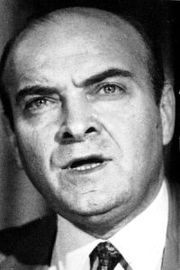
Free trade
Under a free trade policy, prices emerge from supply and demand, and are the sole determinant of resource allocation. 'Free' trade differs from other forms of trade policy where the allocation of goods and services among trading countries are determined by price strategies that may differ from...
, deregulation
Deregulation
Deregulation is the removal or simplification of government rules and regulations that constrain the operation of market forces.Deregulation is the removal or simplification of government rules and regulations that constrain the operation of market forces.Deregulation is the removal or...
, and privatisation. Seeing very mixed results at first, he then appointed former Central Bank head Domingo Cavallo
Domingo Cavallo
Domingo Felipe "Mingo" Cavallo is an Argentine economist and politician. He has a long history of public service and is known for implementing the Convertibilidad plan, which fixed the dollar-peso exchange rate at 1:1 between 1991 and 2001, which brought the Argentine inflation rate down from over...
as Minister of the Economy. Cavallo implemented radical monetary reform
Monetary reform
Monetary reform describes any movement or theory that proposes a different system of supplying money and financing the economy from the current system.Monetary reformers may advocate any of the following, among other proposals:...
s in April 1991, which pegged
Fixed exchange rate
A fixed exchange rate, sometimes called a pegged exchange rate, is a type of exchange rate regime wherein a currency's value is matched to the value of another single currency or to a basket of other currencies, or to another measure of value, such as gold.A fixed exchange rate is usually used to...
the new Argentine peso
Argentine peso
The peso is the currency of Argentina, identified by the symbol $ preceding the amount in the same way as many countries using dollar currencies. It is subdivided into 100 centavos. Its ISO 4217 code is ARS...
to the U.S. dollar and limited the growth in the monetary base
Monetary base
In economics, the monetary base is a term relating to the money supply , the amount of money in the economy...
by law to the growth in reserves
Reserve currency
A reserve currency, or anchor currency, is a currency that is held in significant quantities by many governments and institutions as part of their foreign exchange reserves...
; the 1991 "Convertibility Law" (Ley de Convertibilidad) also established a quasi-currency board
Argentine Currency Board
The Argentine Currency Board pegged the Argentine peso to the U.S. dollar between 1991 and 2002 in an attempt to eliminate hyperinflation and stimulate economic growth. While it initially met with considerable success, the board's actions ultimately failed. In contrast of what most people think,...
. The government privatised most state-controlled companies, opened the economy to foreign trade and investment and created workers compensation systems and private, elective pension funds.
Inflation (1300% in 1990) fell to 84% in 1991 and to single digits by 1993; GDP rebounded, growing by 5.5% on average between 1990 and 1998. A boom in the early 1990s was followed by more erratic growth after 1994.
Privatizations yielded mixed results and some became poster children of mismanagement (Aerolíneas Argentinas
Aerolíneas Argentinas
Aerolíneas Argentinas , formally Aerolíneas Argentinas S.A., is Argentina's largest airline and serves as the country's flag carrier. Owned in its majority by the Argentine Government, the airline is headquartered in the Torre Bouchard, located in San Nicolás, Buenos Aires...
, notoriously). The structural reforms nonetheless provided stability and boosted confidence after decades of decline and chronic bouts of high inflation. These changes fostered major new investments in services and industry in the 1990s, particularly in the telecommunications, food processing
Cuisine of Argentina
Argentine cuisine may be described as a cultural blending of indigenous Mediterranean influences with the wide scope of livestock and agricultural products that are abundant in the country...
, banking
Banking in Argentina
During the 1990s, marked by President Carlos Menem's policies of liberalization, Argentina's financial system saw a significant consolidation and strengthening, in large part through foreign investment...
, freight rail
Rail transport in Argentina
The Argentine railway network comprised of track at the end of the Second World War and was, in its time, one of the most extensive and prosperous in South America. However, with the increase in highway construction, there followed a sharp decline in railway profitability, leading to the break-up...
, energy
Electricity sector in Argentina
The electricity sector in Argentina constitutes the third largest power market in Latin America. It relies mostly on thermal generation and hydropower generation , with new renewable energy technologies barely exploited. The country still has a large untapped hydroelectric potential...
and mining
Mining
Mining is the extraction of valuable minerals or other geological materials from the earth, from an ore body, vein or seam. The term also includes the removal of soil. Materials recovered by mining include base metals, precious metals, iron, uranium, coal, diamonds, limestone, oil shale, rock...
sectors.
Menem and Cavallo also cultivated trade relations with Argentina's neighbors, particularly Brazil. Inheriting negotiations begun in 1985, they secured the formal treaty
Treaty of Asunción
The Treaty of Asunción was a treaty between the countries of Argentina, Brazil, Paraguay, and Uruguay signed on March 26, 1991. The objective of the treaty, signed in Asunción, was to establish a common market among the participating countries, popularly called Mercosur...
that instituted the MERCOSUR
Mercosur
Mercosur or Mercosul is an economic and political agreement among Argentina, Brazil, Paraguay and Uruguay. Founded in 1991 by the Treaty of Asunción, which was later amended and updated by the 1994 Treaty of Ouro Preto. Its purpose is to promote free trade and the fluid movement of goods, people,...
common market in March 1991, and Brazil soon became Argentina's largest trading partner.
Fixed investment
Fixed investment
Fixed investment in economics refers to investment in fixed capital, i.e., tangible capital goods , or to the replacement of depreciated capital goods which have been scrapped....
more than doubled from 1990 to 1994 and partly as a result, Argentina's exports leapt from about US$12 billion in 1992 to around US$26 billion by 1997. The strong, fixed exchange rate, however, soon made imports a bargain again and the trade balance turned in a cumulative US$22 billion in deficits between 1992 and 1999, including several billion from Brazil (putting strain on MERCOSUR).
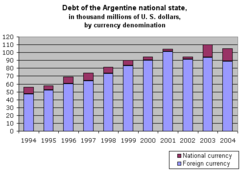
Historical exchange rates of Argentine currency
The following table contains the monthly historical exchange rate of the different currencies of Argentina, expressed in Argentine currency units per United States dollar...
parity under such pressure, the foreign debt quickly ballooned again. The national public debt, now mostly comprised by bonds
Bond (finance)
In finance, a bond is a debt security, in which the authorized issuer owes the holders a debt and, depending on the terms of the bond, is obliged to pay interest to use and/or to repay the principal at a later date, termed maturity...
denominated in dollars, increased continuously, growing by more than 60% between 1994 and 1999.
The opening of the economy to imports, higher productivity and the deregulation of the labour market also fostered unemployment
Unemployment
Unemployment , as defined by the International Labour Organization, occurs when people are without jobs and they have actively sought work within the past four weeks...
, which went from less than 7% in 1991 to over 12% in 1994 and, propelled by the Mexican shock, to over 18% in 1995. Though recovery soon brought some relief, unemployment had only declined to 12% by the time GDP peaked, in mid-1998.
These problems notwithstanding, Argentina was still considered a model for free market reforms among developing countries and after the successful auction of "Brady
Nicholas F. Brady
Nicholas Frederick Brady was United States Secretary of the Treasury under Presidents Ronald Reagan and George H. W. Bush, and is also known for articulating the Brady Plan in March 1989.-Early life:...
Bonds" in 1992, the central government was able to indebt itself entirely through the sale of treasury bonds
Bond (finance)
In finance, a bond is a debt security, in which the authorized issuer owes the holders a debt and, depending on the terms of the bond, is obliged to pay interest to use and/or to repay the principal at a later date, termed maturity...
to support this model. The central bank raised almost US$100 billion this way by 2000 and Argentine debt became the most securitized (or, dependent on free bond markets instead of on direct loans) in the developing world.
International instability
In 1995, the Mexican peso crisis1994 economic crisis in Mexico
The 1994 Economic Crisis in Mexico, widely known as the Mexican peso crisis, was caused by the sudden devaluation of the Mexican peso in December 1994....
produced capital flight
Capital flight
Capital flight, in economics, occurs when assets and/or money rapidly flow out of a country, due to an economic event and that disturbs investors and causes them to lower their valuation of the assets in that country, or otherwise to lose confidence in its economic...
, the loss of banking system deposits and a brief though severe recession
Recession
In economics, a recession is a business cycle contraction, a general slowdown in economic activity. During recessions, many macroeconomic indicators vary in a similar way...
; a series of reforms to bolster the domestic banking system followed. Real GDP growth recovered strongly, reaching 8% in 1997.
In 1998, international financial turmoil caused by Russia's problems and increasing investor anxiety over Brazil produced the highest domestic interest rates in more than three years, halving the growth rate of the economy.
While macroeconomics
Macroeconomics
Macroeconomics is a branch of economics dealing with the performance, structure, behavior, and decision-making of the whole economy. This includes a national, regional, or global economy...
recovered fairly quickly from the effects of the Mexican crisis of 1994-95
1994 economic crisis in Mexico
The 1994 Economic Crisis in Mexico, widely known as the Mexican peso crisis, was caused by the sudden devaluation of the Mexican peso in December 1994....
(known as the Tequila Effect), Argentina could not return to strong growth after the recession
Recession
In economics, a recession is a business cycle contraction, a general slowdown in economic activity. During recessions, many macroeconomic indicators vary in a similar way...
that followed the successive shocks from Asia, Russia and Brazil.
Economic crisis
In 1999, following the 1998 international crisis, GDP fell by 3% and Argentina entered into a recession. President Fernando de la RúaFernando de la Rúa
Fernando de la Rúa is an Argentine politician. He was president of the country from December 10, 1999 to December 21, 2001 for the Alliance for Work, Justice and Education ....
, who took office in December 1999 following the 10-year administration of Carlos Menem
Carlos Menem
Carlos Saúl Menem is an Argentine politician who was President of Argentina from 1989 to 1999. He is currently an Argentine National Senator for La Rioja Province.-Early life:...
, sponsored tax increases and spending cuts to reduce the deficit, which had ballooned to 2.5% of GDP. The new government also arranged a new US$7.4 billion stand-by facility with the International Monetary Fund
International Monetary Fund
The International Monetary Fund is an organization of 187 countries, working to foster global monetary cooperation, secure financial stability, facilitate international trade, promote high employment and sustainable economic growth, and reduce poverty around the world...
(IMF) for contingency purposes almost three times the size of the previous arrangement. The new government passed laws intended to change the country's labour code, and attempted to address the precarious financial situation of several highly indebted provinces.
The issue of Argentina's massive public debt and chronic budget deficits increased market uncertainty, despite a loan guarantee arranged between the Argentine government and the IMF in January 2001. Pres. de la Rúa's March appointment of Domingo Cavallo
Domingo Cavallo
Domingo Felipe "Mingo" Cavallo is an Argentine economist and politician. He has a long history of public service and is known for implementing the Convertibilidad plan, which fixed the dollar-peso exchange rate at 1:1 between 1991 and 2001, which brought the Argentine inflation rate down from over...
to the Economy Ministry and a debt swap
Swap (finance)
In finance, a swap is a derivative in which counterparties exchange certain benefits of one party's financial instrument for those of the other party's financial instrument. The benefits in question depend on the type of financial instruments involved...
arranged by Cavallo was interpreted as panic, however, and capital flight increased. Argentine debt, held mostly in bonds, was massively sold short
Put option
A put or put option is a contract between two parties to exchange an asset, the underlying, at a specified price, the strike, by a predetermined date, the expiry or maturity...
and the government found itself unable to borrow or meet debt payments. The crisis exploded in December after the corralito
Corralito
Corralito was the informal name for the economic measures taken in Argentina at the end of 2001 by Minister of Economy Domingo Cavallo in order to stop a bank run, and which were fully in force for one year. The corralito almost completely froze bank accounts and forbade withdrawals from U.S...
(an almost complete freezing of bank deposits) caused widespread protests
Cacerolazo
A cacerolazo or cacerolada is a form of popular protest practised in certain Spanish-speaking countries – in particular Argentina and Chile – which consists in a group of people creating noise by banging pots, pans, and other utensils in order to call for attention...
. Following the December 2001 riots
December 2001 riots (Argentina)
The December 2001 uprising was a period of civil unrest and rioting in Argentina, which took place during December 2001, with the most violent incidents taking place on December 19 and December 20 in the capital, Buenos Aires, Rosario and other large cities around the country.- Background :The...
, President de la Rúa resigned.
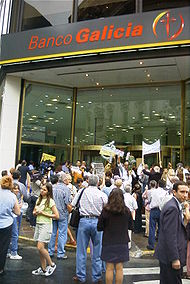
Adolfo Rodríguez Saá
Adolfo Rodríguez Saá Páez Montero is an Argentine Peronist politician. He was the governor of the province of San Luis during several terms, and briefly served as President of Argentina.-Biography:...
declared a short-lived debt moratorium
Moratorium (law)
A moratorium is a delay or suspension of an activity or a law. In a legal context, it may refer to the temporary suspension of a law to allow a legal challenge to be carried out....
. After a few days, Argentina officially defaulted
Default (finance)
In finance, default occurs when a debtor has not met his or her legal obligations according to the debt contract, e.g. has not made a scheduled payment, or has violated a loan covenant of the debt contract. A default is the failure to pay back a loan. Default may occur if the debtor is either...
on $132 billion of its debt, mostly the securitized bonds.
In January 2002, the convertibility plan that pegged the Argentine peso to the U.S. dollar on a one-to-one basis was scrapped, after nearly 11 years. The peso was floated and suffered a swift and sharp devaluation
Devaluation
Devaluation is a reduction in the value of a currency with respect to those goods, services or other monetary units with which that currency can be exchanged....
(losing about 70% of its value in four months), which in turn triggered a 40% surge in consumer prices.
In 2002, Argentina's GDP
Measures of national income and output
A variety of measures of national income and output are used in economics to estimate total economic activity in a country or region, including gross domestic product , gross national product , and net national income . All are specially concerned with counting the total amount of goods and...
sunk by 11%; GDP fell to its 1993 level and on a per capita basis, to that of 1968. Income poverty in Argentina grew from an already high 35.4% in October 2001 to a peak of 54.3% in October 2002; the poverty rate in 2007 returned to levels prevailing in the 1990s and has declined (albeit more slowly) to around 18%, since then. Unemployment, having exceeded 20% in 2002, has also lessened; it has averaged around 8% since 2007.
A measure of financial stability returned after April 2002, and the first sector to recover was manufacturing, where most industries, save food processing (the largest), were operating at below half of capacity. One of the early contributors to this was the recovered factory movement, whereby laid-off workers took over numerous shuttered manufacturers, notably Zanon Ceramics
FaSinPat
FaSinPat, formerly known as Zanon, is a worker-controlled ceramic tile factory in the southern Argentine province of Neuquén, and one of the most prominent in the recovered factory movement of Argentina...
in Neuquén
Neuquén
Neuquén is the name of the following things:* Neuquén, Argentina* Neuquén Province* Neuquén River* Neuquén Group...
and Brukman Textiles
Brukman factory
Brukman is a textile factory in Balvanera, Buenos Aires, Argentina . Currently under the control of a worker cooperative called "18 de Diciembre", it is among the most famous of the country's "recovered factories".-Background:...
in Buenos Aires
Buenos Aires
Buenos Aires is the capital and largest city of Argentina, and the second-largest metropolitan area in South America, after São Paulo. It is located on the western shore of the estuary of the Río de la Plata, on the southeastern coast of the South American continent...
, as well as well-known names outside industry, such as Buenos Aires' Hotel Bauen
Hotel Bauen
The Hotel Bauen is a recuperated business located at 360 Callao Avenue in Buenos Aires run collectively by its workers, serving both as a hotel and as a free meeting place for Argentine leftist and workers' groups...
. These arrangements employed around 15,000 workers by 2004, a small but inspiring contribution to the nation's economy.
Debt restructuring and the role of the IMF
In a speech before the United NationsUnited Nations
The United Nations is an international organization whose stated aims are facilitating cooperation in international law, international security, economic development, social progress, human rights, and achievement of world peace...
General Assembly
United Nations General Assembly
For two articles dealing with membership in the General Assembly, see:* General Assembly members* General Assembly observersThe United Nations General Assembly is one of the five principal organs of the United Nations and the only one in which all member nations have equal representation...
in May 2004, President Kirchner asked for "a structural redesign of the International Monetary Fund
International Monetary Fund
The International Monetary Fund is an organization of 187 countries, working to foster global monetary cooperation, secure financial stability, facilitate international trade, promote high employment and sustainable economic growth, and reduce poverty around the world...
", which has changed "from being a lender for development to a creditor demanding privileges".
Shortly afterwards, at the meeting of the IMF and the World Bank
World Bank
The World Bank is an international financial institution that provides loans to developing countries for capital programmes.The World Bank's official goal is the reduction of poverty...
, leaders of the IMF, the European Union
European Union
The European Union is an economic and political union of 27 independent member states which are located primarily in Europe. The EU traces its origins from the European Coal and Steel Community and the European Economic Community , formed by six countries in 1958...
, the Group of Seven industrialised nations, and the Institute of International Finance
Institute of International Finance
The Institute of International Finance, Inc. is the world's only global association of financial institutions. It was created by 38 banks of leading industrialised countries in 1983 in response to the international debt crisis of the early 1980s...
(IIF), advised Kirchner that Argentina must come to a debt-restructuring agreement, increase its primary budget surplus to pay more debt and impose "structural reforms" to regain the trust of the world financial community.
The debt restructuring process
Argentine debt restructuring
Argentina went through an economic crisis beginning in the mid-1990s, with full recession between 1999 and 2002; though it is debatable whether this crisis has ended, the situation has been more stable, and improving, since 2003....
was long and complex. Argentina offered a steep discount on its obligations (approximately 70%) and finally settled the matter with over 76% of its defaulted creditors (the default did not include the IMF, which has continued to be paid on time).
In December 2005, Kirchner decided to liquidate the Argentine debt to the IMF in a single payment, without refinancing, for a total of $9.8 billion. The payment was partly financed by Venezuela, who bought Argentine bonds for US$1.6 billion.
In 2006, Argentina reentered international debt markets selling US$500 million of its Bonar V five year dollar denominated bonds, with a yield of 8.36%, mostly to foreign banks and Moody's
Moody's
Moody's Corporation is the holding company for Moody's Analytics and Moody's Investors Service, a credit rating agency which performs international financial research and analysis on commercial and government entities. The company also ranks the credit-worthiness of borrowers using a standardized...
boosted Argentina's debt rating to B from B-. However, the reliance of Argentina on Venezuela for a large portion of its financing needs has not been well received in Wall Street circles. On July 18, 2006 Goldman Sachs
Goldman Sachs
The Goldman Sachs Group, Inc. is an American multinational bulge bracket investment banking and securities firm that engages in global investment banking, securities, investment management, and other financial services primarily with institutional clients...
Emerging Markets Research noted: "Instead of trying to restore its credibility with the broad capital markets, the government keeps on relying on Venezuela as its main credit supplier" (as quoted in the Wall Street Journal on July 28, 2006). The total amount of Argentina's debt held by Venezuela is estimated at around US$6 billion, as of mid-2008.
Continuing her husband's policy of debt cancellation, President Cristina Kirchner announced the initiation of the repayment of Argentina's US$6.7 billion debt to Paris Club
Paris Club
The Paris Club is an informal group of financial officials from 19 of some of the world's biggest economies, which provides financial services such as war funding, debt restructuring, debt relief, and debt cancellation to indebted countries and their creditors...
creditors in September 2008, and in April 2010, Economy Minister Amado Boudou
Amado Boudou
Amado Boudou is an Argentine businessman and government policy maker who serves as Minister of the Economy since 2009. He was elected Vice President of Argentina as running mate of Cristina Fernández de Kirchner in the 2011 general election.-Early life and career:Amado Boudou was born in Mar del...
prepared a debt swap
Debt restructuring
Debt restructuring is a process that allows a private or public company – or a sovereign entity – facing cash flow problems and financial distress, to reduce and renegotiate its delinquent debts in order to improve or restore liquidity and rehabilitate so that it can continue its...
package for the holders of over US$18 billion in bonds who did not participate in the 2005 Argentine debt restructuring
Argentine debt restructuring
Argentina went through an economic crisis beginning in the mid-1990s, with full recession between 1999 and 2002; though it is debatable whether this crisis has ended, the situation has been more stable, and improving, since 2003....
prepared by a Economy Minister Roberto Lavagna
Roberto Lavagna
Roberto Lavagna is an Argentine economist and politician, and was the former Minister of Economy and Production of Argentina from April 27, 2002, to November 28, 2005.-Career:...
. These holdout
Holdout problem
In finance, a holdout problem occurs when a bond issuer is in default or nears default, and launches an exchange offer in an attempt to restructure debt held by existing bond holders...
s include numerous vulture fund
Vulture fund
A vulture fund is a private equity or hedge fund that invests in debt issued by an entity that is considered to be very weak or dying, or whose debt is in imminent default. The name is a metaphor comparing these investors to vultures patiently circling, waiting to pick over the remains of a rapidly...
s which had eschewed the 2005 offer, and had instead resorted to the courts in a bid for higher returns on their defaulted bonds. These disputes had led to a number of liens against central bank accounts in New York
New York
New York is a state in the Northeastern region of the United States. It is the nation's third most populous state. New York is bordered by New Jersey and Pennsylvania to the south, and by Connecticut, Massachusetts and Vermont to the east...
and, indirectly, to reduced Argentine access to international credit markets.
Economic expansion

Economic growth
In economics, economic growth is defined as the increasing capacity of the economy to satisfy the wants of goods and services of the members of society. Economic growth is enabled by increases in productivity, which lowers the inputs for a given amount of output. Lowered costs increase demand...
again with surprising strength: 9% annual growth, sustained for five consecutive years (2003 through 2007). This stability was initially due to a surge in trade surpluses (over all previous historical records) and the sustained growth has been led by an over three-fold jump in business investment
Fixed investment
Fixed investment in economics refers to investment in fixed capital, i.e., tangible capital goods , or to the replacement of depreciated capital goods which have been scrapped....
since the 2002 low. This reflects the return of local and international confidence, as well as record public works
Public works
Public works are a broad category of projects, financed and constructed by the government, for recreational, employment, and health and safety uses in the greater community...
investment and a vigorous incomes policy
Incomes policy
Incomes policies in economics are economy-wide wage and price controls, most commonly instituted as a response to inflation, and usually below market level.Incomes policies have often been resorted to during wartime...
on the part of former Economy Minister Lavagna and as general policy in the two Kirchner
Kirchnerism
Kirchnerism is a term used to refer to the political philosophy and supporters of Néstor Kirchner, president of Argentina from 2003 to 2007, and of his wife Cristina Fernández de Kirchner, President from 2007...
Administrations. Private sector employers have, since then, created over 3 million jobs and recovered median pay to over US$800 a month (about US$1,600, in purchasing power parity terms), a level closer to Argentina's historical average. This has boosted local consumption by two-thirds in real terms, though foreign investment has increased only modestly.
The Kirchners have also addressed deficiencies among certain public services privatized during the 1990s, revoking licences granted to private interests at the time; among these, some of the most notable have been: the national postal service (2003), the San Martín Railway line (2004), the water utility serving the Province of Buenos Aires (2006) and Aerolíneas Argentinas
Aerolíneas Argentinas
Aerolíneas Argentinas , formally Aerolíneas Argentinas S.A., is Argentina's largest airline and serves as the country's flag carrier. Owned in its majority by the Argentine Government, the airline is headquartered in the Torre Bouchard, located in San Nicolás, Buenos Aires...
(2009). Private pension funds, which were first licenced in 1994, suffered large losses during the 1998–2002 crisis and by 2008, the state subsidized 77% of the funds' beneficiaries, including 40% whose annuities could not cover minimum monthly pensions; of the funds' 9.5 million affiliates, nearly 6 million had stopped making contributions. The 2008 financial crisis exacerbated the problem and on 20 October, Pres. Cristina Kirchner announced plans for the nationalization of the funds' investments of nearly US$30 billion, while leaving contributors the freedom to invest in private pension funds, which the central bank would purchase a minority stake in. The plan's congressional passage a month later was accompanied by a package of incentives designed to make credit more accessible and to stimulate slowing domestic growth, as well as expanded export and loan subsidies and a US$32 billion public works program for 2009–2010 (a record).
The program helped stave off a recession, though the effects of the international crisis did have a serious impact on the local economy. Following six years of the fastest, sustained economic growth since the 1880s, GDP slid by 1.5% from July 2008 to July 2009, and domestic, private sector demand fell by around 4%. Sharp increases in public spending in the first half of 2009 and an incipient recovery in the second half of the year resulted in growth of 0.8% for 2009 as a whole, and although inflation rates rose again, the economy grew by around 8% in 2010.
Benefiting from an undervalued local currency that allowed industry to produce goods with competitive prices in the international market, exports soared from US$26 billion in 2002 to US$70 billion in 2008. A drought and weaker international demand caused exports to fall by 20% during 2009, though these recovered by the following year. The discovery of the largest new natural gas
Natural gas
Natural gas is a naturally occurring gas mixture consisting primarily of methane, typically with 0–20% higher hydrocarbons . It is found associated with other hydrocarbon fuel, in coal beds, as methane clathrates, and is an important fuel source and a major feedstock for fertilizers.Most natural...
deposits in 35 years, made in the energy-rich Neuquén Province
Neuquén Province
Neuquén is a province of Argentina, located in the west of the country, at the northern end of Patagonia. It borders Mendoza Province to the north, Rio Negro Province to the southeast, and Chile to the west...
in 2010, made the prospect of discontinuing costly gas imports from Bolivia
Bolivia
Bolivia officially known as Plurinational State of Bolivia , is a landlocked country in central South America. It is the poorest country in South America...
a possibility, and indirectly benefits Chile
Chile
Chile ,officially the Republic of Chile , is a country in South America occupying a long, narrow coastal strip between the Andes mountains to the east and the Pacific Ocean to the west. It borders Peru to the north, Bolivia to the northeast, Argentina to the east, and the Drake Passage in the far...
(Argentina's largest energy buyer), as well.
Manufacturing
Manufacturing
Manufacturing is the use of machines, tools and labor to produce goods for use or sale. The term may refer to a range of human activity, from handicraft to high tech, but is most commonly applied to industrial production, in which raw materials are transformed into finished goods on a large scale...
in Argentina has also recovered quickly from the 2002 crisis. Led by higher domestic demand, manufacturing in general had nearly doubled in volume by 2010; some long-suffering industries, such as textiles, furniture
Furniture
Furniture is the mass noun for the movable objects intended to support various human activities such as seating and sleeping in beds, to hold objects at a convenient height for work using horizontal surfaces above the ground, or to store things...
, machinery, construction
Construction
In the fields of architecture and civil engineering, construction is a process that consists of the building or assembling of infrastructure. Far from being a single activity, large scale construction is a feat of human multitasking...
materials and publishing
Publishing
Publishing is the process of production and dissemination of literature or information—the activity of making information available to the general public...
have more than doubled their output. Motor vehicle output, in particular, has jumped from a depressed 159,000 units in 2002 to a record 724,000 units in 2010. While local home values remain well below international prices, the nation's real estate
Real estate
In general use, esp. North American, 'real estate' is taken to mean "Property consisting of land and the buildings on it, along with its natural resources such as crops, minerals, or water; immovable property of this nature; an interest vested in this; an item of real property; buildings or...
market has also remained strong.
Though nothing new to Argentina, inflation has also proven difficult to contain. Price stability returned quickly after the 2002 crisis and President Kirchner inherited annual inflation in the 3-4% range. The robust recovery that followed has been accompanied by growth in median incomes averaging 17% (including a 25% jump in the year to April 2008, alone); but it has also seen a 26% average expansion in the monetary base
Monetary base
In economics, the monetary base is a term relating to the money supply , the amount of money in the economy...
.
The Kirchner Administration began pursuing a price truce with retailers as early as 2005; but, with macroeconomic pressures at these levels, the initiative soon failed. To make matters worse, in early 2007 the administration began interfering with inflation estimates and, as of mid-2009, continues to do so (by how much, of course, remains a subject of debate; but, where the Economy Ministry has refused to acknowledge inflation
Inflation
In economics, inflation is a rise in the general level of prices of goods and services in an economy over a period of time.When the general price level rises, each unit of currency buys fewer goods and services. Consequently, inflation also reflects an erosion in the purchasing power of money – a...
greater than 10%, their own measure of implicit private consumption prices (a factor in GDP estimates) suggests inflation had reached nearly 20% by mid-2008, and remains in the order of 15%).
Further reading
- Bulmer-Thomas, Victor. The Economic History of Latin America since Independence (New York: Cambridge University Press). 2003.
- The Crisis that Was Not Prevented: Lessons for Argentina, the IMF, and Globalisation, Jan Joost Teunissen and Age Akkerman (eds.), Fondad, 2003, book, pdf
- Who Shot Argentina? The Finger Prints On the Smoking Gun Read ‘I.M.F.', Greg Palast, The Guardian (London) Sunday, August 12, 2001

